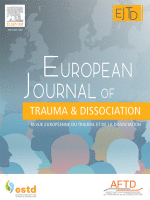European Journal of Trauma & Dissociation
Comment:
Women featured in pornography often experience cyberbullying, physical injuries, and emotional distress as a consequence.
Fabienne El-Khoury Lesueur,Véronique Héroin,Marion Fareng, December, 2024
Abstract
Context
Several reports have shed light on the potentially traumatic filming conditions, and violence experienced by women featured in pornography (WP). However, there is a scarcity of research on the mental health of these women, as well as the perceived consequences of participation in Video-based Pornography (VbP).
Methods
Thirty-six women, recruited through collaboration with WP support groups, completed an online questionnaire covering socio-demographics, pre-VbP violence experiences, and perceived consequences of their participation in VbP. Additionally, participants completed the French versions of the post-traumatic stress disorder (PTSD) Checklist for DSM-5 (PCL-5), the Dissociative Experiences Scale (DES-II), and the 13-item Beck Depression Inventory (BDI-13).
Results
The participants had a mean age of 31.2 years (SD = 7), and the median age at first participation in VbP was 21. A majority (77.8 %) reported a lifetime experience of sexual violence before featuring in VbP. All participants reported at least one negative effect of participating in VbP, with three in four women citing cyberbullying following VbP dissemination. Additionally, participants reported a range of physical consequences such as vaginal lesions and sexually transmitted diseases. Thirty women (83 %) had a PCL-5 score over 33, indicative of probable PTSD, and 28 women (78 %) had a DES-II score of 30 or more, indicating high levels of dissociative symptoms. Furthermore, 19 women (53 %) reported a BDI-13 score over 13, suggesting potential severe depression.
Conclusion
This study underscores psychosocial vulnerabilities and the presence of severe psychopathology among WP. It also documents their perceptions of negative consequences of participation in VbP, such as cyberbullying, physical injuries, and emotional distress. Further, large-scale studies are needed to substantiate these results and better understand the scale of the problem, as well as to optimize care interventions.
